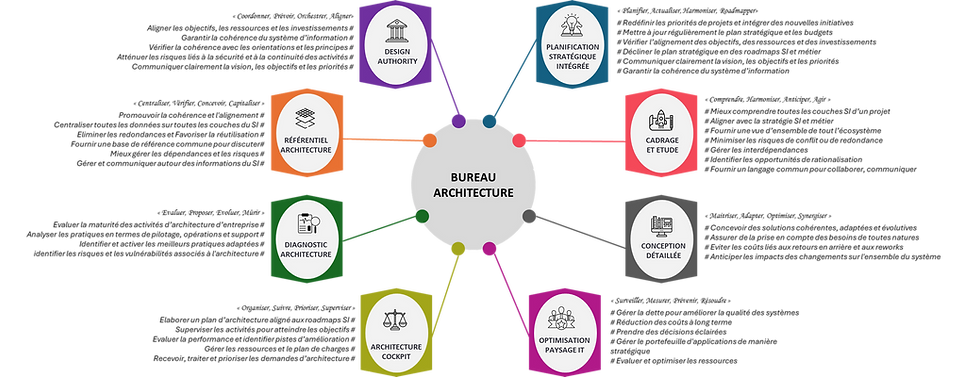Design Authority: the safeguard that prevents zombie projects and aligns transformations
- Gabriel Amine Ghalleb
- Jul 24
- 3 min read
There's a lot of talk about digitalization, the cloud, AI, cybersecurity, and IT modernization. Projects are plentiful. Committees are multiplying. And yet... many organizations are drifting, multiplying inconsistencies, reworks, poorly managed dependencies, siloed solutions, and the notorious "zombie projects": launched, funded, but without a clear purpose or strategic alignment.
One question keeps coming up: How can we avoid zombie projects, inconsistent architectures, and wasted budgets?
The answer is two words: Design Authority.
But be careful: not in the sense of a rubber-stamp "committee." This is an active, permanent, cross-functional function, central to managing the transformation.

What is a Design Authority (DA)?
The Design Authority is a function of continuous orchestration of the consistency of projects with the principles, strategic objectives and target architectures.
She is neither a policeman nor a validator after the fact: she is a partner in change , who supports teams and informs decisions.
Its role is simple:
Align strategy, business needs, solutions and execution at all times.
Avoid dead ends, redundancies, and disconnections between initiatives.
Accelerate delivery by securing choices from the start.
Main missions of a Design Authority
A Design Authority acts throughout the entire life cycle of a project, in conjunction with the business and IT teams:
Upstream
Challenging the framing of needs
Ensure alignment with target IS functions using the Capability Map
Assess the impacts (functional, IS, data, security)
Ensure consistency with architectural principles
Integrate existing repositories (processes, solutions, data)
During design
Challenge target architectures with teams
Identify dependencies and risks
Validate the structuring choices
During delivery
Participate in design reviews, agile reviews, project committees
Unlocking friction points between business and IT
Alert on deviations or misaligned choices
In capitalization
Update guiding principles, approaches and models
Strengthening good practices
Animate the community of architects and project managers

What makes up an effective Design Authority?
DA is multidisciplinary, like the transformations it supports:
Enterprise architects : global vision, master plan, business architecture, roadmapping, various layers of architecture, alignment, principles...
Solution & technical architects : technical consistency, reusable patterns.
Business experts : those responsible for business needs and priorities.
Data & security : cross-functional requirements.
Project managers / PMO : link with execution.
Its operation is based on:
Rituals integrated into the life of projects, from the framing to delivery: no rigid committees, but regular and targeted interventions at key moments.
A capacity to intervene quickly, without waiting for a monthly committee : the Design Authority acts continuously, throughout discussions, to unblock, advise, and validate.
A cross-functional and fluid dialogue between the professions, architects and project managers , with a posture of support and constructive challenge.
A common language based on universal languages, shared and known methods, tools, approaches and architectural references, to ensure consistency and clarity in all decisions.
What concrete benefits for a CIO, a CTO, a CDO?
For the CIO:
Streamline delivery and reduce project drift
Ensure the consistency of the IS with the modernization/transformation objectives
Better management of IT decisions
For the CTO:
Maintain technical control and limit debt
Secure the scalability of solutions
Avoiding technological proliferation
For the CDO:
Align digital projects with target strategy & customer experience
Strengthening the value of initiatives
Accelerate delivery cycles while maintaining meaning
And for the company?
Better aligned, faster, less expensive projects
A clear and structured transformation path
Systemic coherence , even in agile and changing contexts
Design Authority or Architecture Firm? Both. One acts, the other supervises.
The Enterprise Architecture Office (EAO) structures the vision, aligns trajectories, and frames the transformation. The Design Authority, the core mission of the EAO, intervenes at the heart of projects to ensure consistency, value, and effective implementation.
Without a vision and framework established by the BAE, the Design Authority loses its compass. Without an active Design Authority, the BAE's strategy remains theoretical, disconnected from the field.
They are inseparable. Together, they avoid zombie projects, reinforced silos, unnecessary reinventions, and structural slippage.
The BAE designs architecture. The Design Authority embodies it every day. That's why the Design Authority is one of the driving forces behind the BAE.
Conclusion: Design Authority, a lever of trust and convergence
Design Authority is not an overlay. It is the silent engine of consistency .
It structures choices without freezing them , accelerates without short-circuiting , and aligns without imposing .
In complex transformations, it is the compass of projects .
It transforms architecture into value.
She doesn't validate. She acts.



Comments